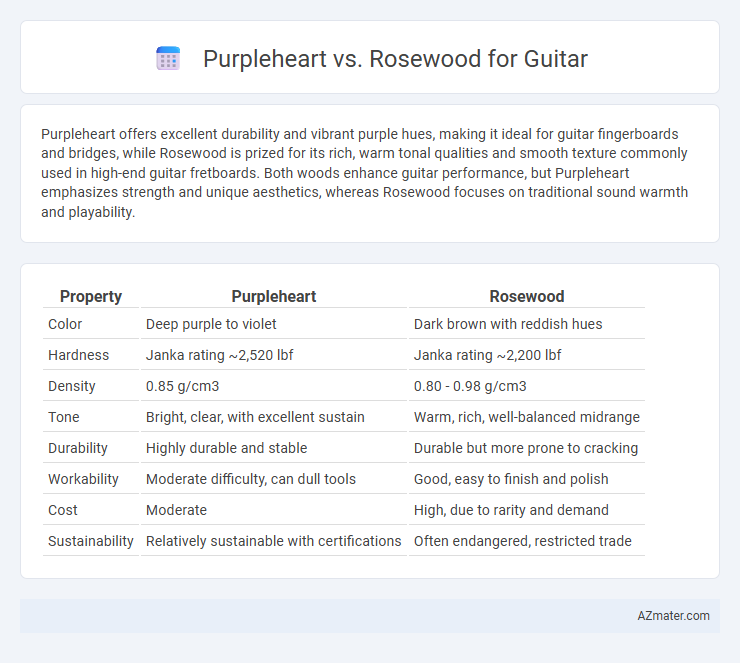Purpleheart offers excellent durability and vibrant purple hues, making it ideal for guitar fingerboards and bridges, while Rosewood is prized for its rich, warm tonal qualities and smooth texture commonly used in high-end guitar fretboards. Both woods enhance guitar performance, but Purpleheart emphasizes strength and unique aesthetics, whereas Rosewood focuses on traditional sound warmth and playability.
Table of Comparison
| Property | Purpleheart | Rosewood |
|---|---|---|
| Color | Deep purple to violet | Dark brown with reddish hues |
| Hardness | Janka rating ~2,520 lbf | Janka rating ~2,200 lbf |
| Density | 0.85 g/cm3 | 0.80 - 0.98 g/cm3 |
| Tone | Bright, clear, with excellent sustain | Warm, rich, well-balanced midrange |
| Durability | Highly durable and stable | Durable but more prone to cracking |
| Workability | Moderate difficulty, can dull tools | Good, easy to finish and polish |
| Cost | Moderate | High, due to rarity and demand |
| Sustainability | Relatively sustainable with certifications | Often endangered, restricted trade |
Introduction to Purpleheart and Rosewood
Purpleheart, known for its vibrant purple hue and dense grain, offers excellent sustain and bright tonal qualities favored in guitar fretboards and bridges. Rosewood, a traditional choice, is prized for its rich, warm sound and natural oily texture that enhances playability and durability. Both woods provide distinct aesthetic and sonic characteristics essential for crafting high-quality guitars.
Origins and Characteristics of Purpleheart
Purpleheart, native to Central and South America, is prized for its vibrant purple hue that darkens with exposure to light. This hardwood is dense and durable, offering excellent sustain and a bright, balanced tone for guitars. Compared to rosewood, which is known for its rich, warm sound and complex grain patterns, purpleheart provides a unique aesthetic and tonal clarity favored by many luthiers.
Origins and Characteristics of Rosewood
Rosewood, primarily sourced from India, Brazil, and Madagascar, is prized for its rich, resonant tone and natural oily texture that enhances durability and smooth playability in guitars. Its dark brown to deep reddish-brown coloration with unique grain patterns contributes to aesthetic appeal and distinct acoustic qualities compared to Purpleheart's dense, bright tonal profile. The dense structure and natural oils of Rosewood provide balanced warmth and sustain, making it a preferred choice for fingerboards, backs, and sides of high-quality guitars.
Visual Differences: Color and Grain Patterns
Purpleheart exhibits a striking deep purple to violet hue that darkens with age, offering a bold and unique appearance for guitar bodies and fretboards. Rosewood features rich brown tones with varied darker streaks and intricate grain patterns, providing a classic, warm look favored by many luthiers. The grain of Purpleheart is generally straighter and more uniform, while Rosewood displays more complex, swirling grains, adding distinct visual textures to each instrument.
Tonal Qualities Compared
Purpleheart delivers a bright, balanced tone with strong midrange presence and clear articulation, making it ideal for players seeking clarity and punch. Rosewood offers warmer, richer sound characterized by deep bass and complex overtones, favored for its resonance and sustain in acoustic guitars. The choice between Purpleheart and Rosewood significantly influences a guitar's tonal character, with Purpleheart emphasizing brightness and Rosewood enhancing warmth and depth.
Durability and Workability
Purpleheart offers exceptional durability with a Janka hardness rating of around 2,520, making it highly resistant to wear and impact, ideal for guitar necks and bodies requiring long-lasting strength. Rosewood, while slightly less hard with a Janka rating between 1,690 and 1,830, is renowned for its smooth workability and rich tonal qualities, allowing for intricate inlays and smooth finishes. Both woods provide excellent stability, but Purpleheart's dense grain demands sharper tools and slower machining compared to the easier-to-shape Rosewood, impacting the choice based on craftsmanship and longevity needs.
Popular Guitar Models Featuring Each Wood
Popular guitar models featuring Purpleheart include the Taylor 322ce and Paul Reed Smith SE Custom 24, valued for its bright tone and durability. Rosewood is commonly used in models like the Martin D-28 and Gibson Les Paul Standard, prized for its warm, rich sound and complex overtones. Both woods enhance the guitar's resonance but cater to different tonal preferences and playing styles.
Sustainability and Environmental Impact
Purpleheart and Rosewood differ significantly in sustainability and environmental impact, with Purpleheart sourced from fast-growing trees in Central and South America, making it a more renewable option. Rosewood, especially species like Brazilian Rosewood, faces critical endangerment due to overharvesting and strict CITES regulations, limiting its availability and raising ethical concerns. Choosing Purpleheart supports responsible forestry practices and reduces ecological damage associated with illegal logging in Rosewood supplies.
Price and Availability
Purpleheart guitars are generally more affordable than rosewood models, with prices often 10-30% lower due to the wood's abundance and faster growth rates. Rosewood is rarer and subject to stricter CITES regulations, making it more expensive and less readily available in global markets. Availability of purpleheart wood is high in South America, while rosewood shortages and export restrictions have led to increased costs and limited supply for manufacturers and consumers.
Choosing the Right Wood for Your Guitar
Purpleheart offers a bright tone with excellent sustain due to its dense grain, making it ideal for guitar fretboards and bridges where articulation is crucial. Rosewood, known for its rich, warm sound and natural oily texture, enhances resonance and provides a comfortable playing feel, commonly preferred for fingerboards and backs. Choosing between Purpleheart and Rosewood depends on your desired tonal clarity versus warmth, as well as considerations for aesthetics, durability, and playability in your instrument.

Infographic: Purpleheart vs Rosewood for Guitar
 azmater.com
azmater.com